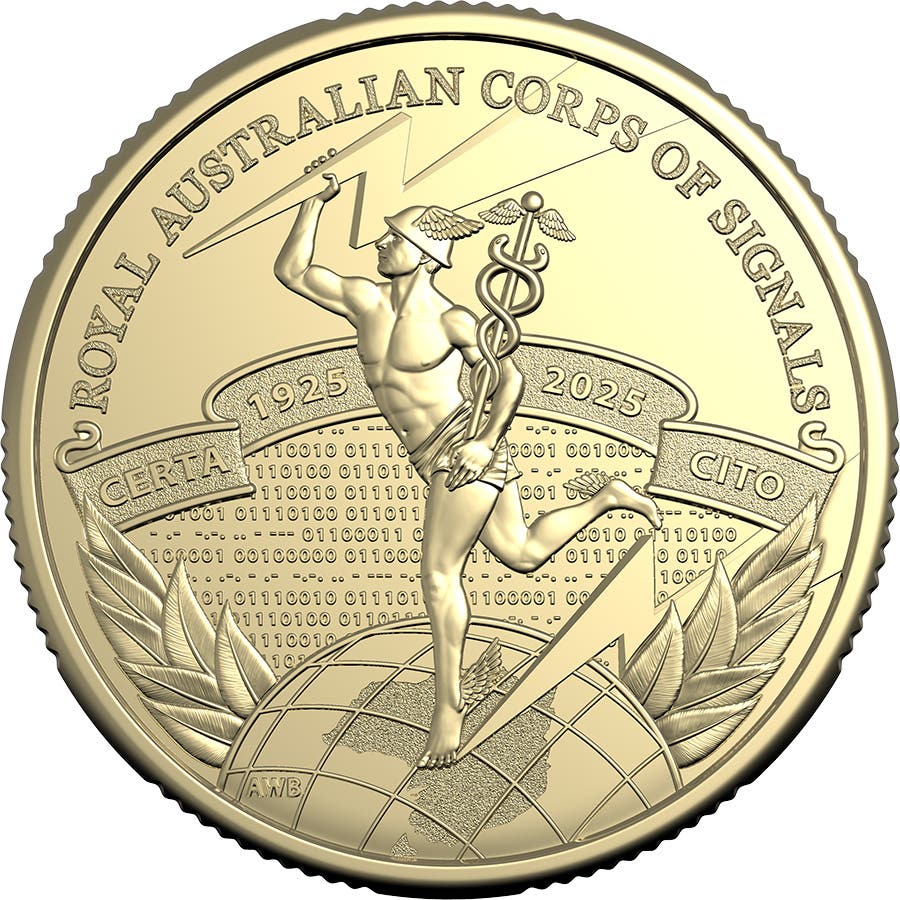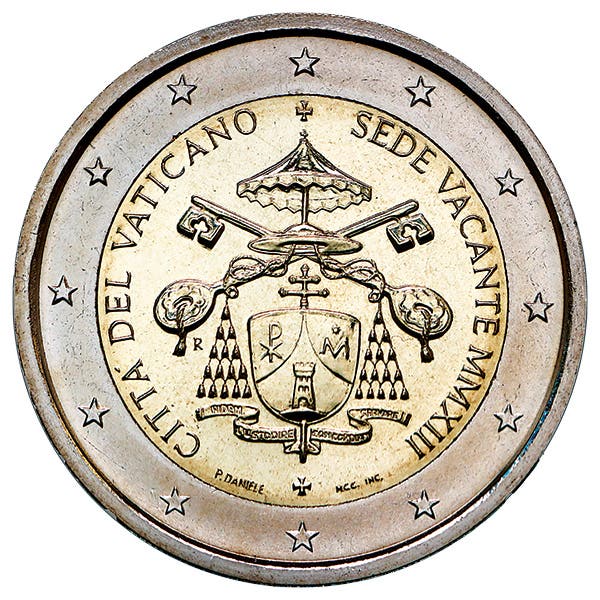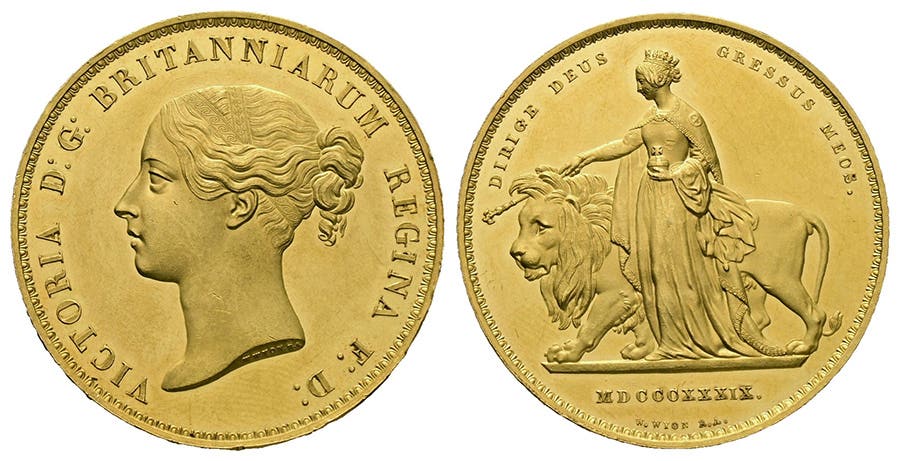The Coinage of Peter I, 1721–1725
In many ways the last years of Czar Peter the Great were just as interesting as his early days in power. A man of great energy and drive, he wanted…
In many ways the last years of Czar Peter the Great were just as interesting as his early days in power. A man of great energy and drive, he wanted above all to bring Russia into the modern age. To what extent he succeeded is still a matter of dispute among historians, but no one doubts that he made every effort to achieve this single objective.
On September 10, 1721, the Russian and Swedish governments had, at long last, signed a treaty of peace at Nystad, ending the Great Northern War which had commenced in 1700. Queen Ulrika of Sweden now bowed to the inevitable and gave up the struggle; Peter the Great had put Russia on the political map of Europe for all time.
The Russian Senate, after some prodding from the proper people, decided that the title of Czar was no longer adequate to describe a ruler of so vast a state and adopted Emperor instead. The change was made at the end of October 1721 but only the gold coinage of that year reflects the new imperial title. This particular 1721 gold coinage is of great rarity and found in few modern collections outside of the largest museums.
In 1722 war with Persia erupted and Peter, after a short campaign, seized a considerable amount of land along the Caspian Sea; some of this was lost to the Persians, however, after Peter’s death in 1725. It was the last territorial acquisition of note under this ruler; in fact, it was not until the reign of Catherine II, 1762–1796, that Russia once more began to take surrounding territory for incorporation into the empire.
One of the more far-reaching decisions made by Peter in 1722 was the creation of the Table of Ranks, which allowed an individual to move up the scale as far as his ability would carry him. The Czar thus created a situation where birth and wealth did not mean as much as service to the State. Many nobles of the later empire were in fact descendants of the most lowly of ancestors; the popular belief that Russia was actually controlled by an ancient nobility is a political fable.
In November 1723 Peter at last publicly recognized his consort, Catherine, as empress and she was formally crowned the following May in a brilliant ceremony held at the ancient Cathedral of the Assumption in the Moscow Kremlin. Catherine now had real power for the first time and used it both foolishly and wisely. She named several to the ranks of the nobility, including Peter Tolstoy, whose famous descendant Leo Tolstoy was to write War and Peace, one of the greatest novels of all time.
On the other hand, she let herself fall under the spell of William Mons, brother of Anna Mons, the mistress of Peter I before 1703. Mons was soon in a position to sell important favors and those who sought the help of the empress first passed through the greedy hands of Mons. The Czar was slow to learn of what was going on but learn he did, and retribution was swift and terrible. Mons was beheaded and relations between Peter and his wife were strained for some time.
Peter had been ill during much of 1724 and seriously aggravated his kidney problem by plunging into an icy river on November 5 to keep several sailors from drowning. (This rescue story is not universally accepted as true.) Even though his health steadily deteriorated from this time, Peter still had time to superintend the creation of the Russian Academy of Sciences, whose star was to shine so brilliantly in the later years of the empire. On January 25, 1725, he died and was succeeded by Catherine.
As noted earlier, the 2-ruble gold coinage of 1721 with the new title is quite rare, but the following years (1722–1725) are not all that common either. There was no change of design or form in 1722, but in 1723 one of the Moscow engravers (Otfrid Koenig ?) produced a new bust of the Czar. Unlike the bust of 1721–1722, which is generally described as being draped and armored, the 1723 version is of a slimmer czar and not nearly so military in form. The coinage of 1724 and 1725 kept the new bust and all were struck at Moscow.
Unlike the gold, the silver coinage of 1721 did not reflect the new imperial title, probably meaning that the necessary obverse dies to last through the end of 1721 had already been prepared by the engraving staff. The most interesting piece of Peter’s last years, however, was not struck during his reign at all. The 1722 silver two rubles is known only from novodels (restrikes) made decades later. It is an impressive coin and would have made a fitting memorial to the giant czar.
The design on the silver rubles was changed for 1722. Instead of the old reverse, with a double-headed eagle, the engravers came up with a monogram reverse in which the letter P (π in the Cyrillic alphabet) forms a cross; it honored not only Peter, but served as a Christian symbol at the same time. Each of the letters was crowned, additional symbolism in an age that thrived on imperial regalia and forms.
The new mint at St. Petersburg, long planned by Peter but delayed on several occasions, began coinage operations in 1724. The first product was the silver ruble and it was the only denomination struck in that first year. On some coins the mintmark is SPV rather than the usual SPB (see table showing the two types in Cyrillic). The 1724 rubles of St. Petersburg are also quite interesting for the small sun in the center of the reverse, giving the name Sun Rubles to these special coins; the device was also used in 1725.
In 1723 the Moscow engraving staff changed their bust of Peter to the slimmer one adopted on the gold during the same year; the more military style (draped armor) was used for the 1724–1725 coinage at St. Petersburg. Moscow used the new bust during the remaining two years of the reign.
Poltinas (half rubles) of 1722–1725 are much more straightforward than the rubles but have their own interesting points. All the poltinas of 1722–1724 were struck at Moscow and in 1723 the slim bust was adopted in this series.
For 1725 poltinas exist for both Moscow and St. Petersburg but the bust for the latter is the usual draped armor. All of the poltinas dated after 1721 have the title of “Emperor” but the reverse eagle remained as it had before 1722. There are several minor variations in the form of the eagle, mostly in the tail feathers. Few collectors in this series concern themselves with anything but date and the major 1723 varieties due to the generally high values for rubles of this ruler.
In most of the years prior to 1722 there had been some minor coinages of silver but none was to take place under Peter after 1721. (Such coins were not struck again until 1726 under Catherine I.) The gold uses only Arabic dates, but the 1722 silver has both Arabic and Cyrillic forms, the last such use of the old system in Russian coinage.Although there is considerable interest in the gold and silver coinage of Peter, it is his copper which attracts the most collectors. His base coinage is fairly common and low-priced, accounting in part for this interest. In 1721 the Moscow Mint was still striking the polushka (quarter kopeck) as the only copper coin, at the rate of 40 rubles (16,000 polushkas) to the pood (16.38 kilograms) of copper. These are indeed tiny coins.
A pood of copper cost the Russian Treasury about 7 rubles, but the price fluctuated according to the fortunes of war and availability of workmen. Whatever the base price, there was still a great profit made by the government in the polushka coinage.
The silver and gold duly reflected the new title of “Emperor,” granted in October 1721, but the copper coinage of 1721-1722 did not do this. Instead the same initials, standing for “Autocrat of All the Russias,” were kept intact throughout 1722, the last date for this style coinage. It is probable that dies dated 1722 were used for the first few months of 1723 while the problem of the copper coinage was being discussed by Treasury officials.
Counterfeiters loved the polushkas coinage of 1718–1722. The quality of the specimens turned out by the Moscow Mint was so poor, in general, that counterfeits were difficult to detect. Most of the false pieces are believed to have been made in Russia, by creative citizens thinking that they, too, could cash in on the great profits being made. The government struck back with draconian penalties, usually death by hanging or the executioner’s axe.
By early 1723 the Treasury had decided to eliminate the quarter kopeck but no one was quite certain what kind of copper coin should replace it. At length, in May 1723 it was decided that the new coin would be a Piatak (5 kopecks). On June 23 the engraving staff of the Moscow Mint was directed to prepare pattern coins for this denomination incorporating special anti-counterfeiting devices.
The engravers prepared three pattern coins, two of which were done first and a third somewhat later. The first showed, on the obverse, the arms of Moscow while the second had Mars, the god of War. Both were well executed for copper coinage of the period but were rejected. The Mars obverse was probably put aside as too warlike while the arms of Moscow may have offended some of the people in St. Petersburg, where the choice was ultimately to be made.
The third pattern, and the one to be adopted, had the double-headed eagle in a small circle and surrounded by five dots of account. The reverse was in the form of a cross, with the denomination (FIVE KOPECKS) and date. The date was always, in Russian fashion, accompanied by the word “goda” (year). In official documents the double-headed eagle is described as the “arms of His Majesty” and not the symbol of the Russian Empire as it would become in later years.
Piataks struck in 1723 and later incorporated an anti-counterfeiting device that was unknown until recently, when V.V. Uzdenikov published the necessary material to understand this curious feature. It is, of course, well known that Russian coins nearly always are struck in medal form; in this case the coins are turned side-by-side to see the back correctly as, for example, on the current coins of Canada. Coin turn, on the other, requires and end-over-end turn for the proper alignment as on U.S. coins.
The piataks of 1723-1730, with one minor exception, were struck with medal turn and the denomination is level when the coin is properly rotated. On genuine coins the date goes upward. In 1727 a few were struck on a medal turn, with the date going down. It is interesting to note that, until Uzdenikov investigated this little-known aspect of Russian coinage, the special arrangement was unknown to scholars such as Chaudoir and the Grand Duke Georgii Mikhailovich.
On July 28 the third pattern was approved and production began soon afterwards. The imperial ukase (decree) authorizing the design stipulated that 500,000 rubles worth of this copper coin (10,000,000 pieces) were to be struck as soon as possible. Yearly figures are unknown but through February 1727 the mintage was 12.1 million coins.
Most of the piataks dated after 1723 have mintmarks, of which there is quite a variety (MD, ND, KD, etc.). In general the 5-kopeck copper coins of this era are relatively easy for the collector to obtain, though specimens in superior condition bring prices in line with the scarcity of such material. The last 5-kopeck copper coin on the 40-ruble standard was struck in 1730.
Despite the better design, and the secret anti-counterfeiting device, false pieces were soon pouring across the frontier; native craftsmen did not have access to the minting machinery necessary for such coinage. The government again struck back with very harsh penalties for anyone connected with such coinage and strict searches were instituted at the frontiers. Rewards were paid to customs officials who uncovered counterfeits. Foreigners, even diplomats, were carefully watched to see if they were exchanging copper coins, genuine or not, for gold or silver to remove from the country.
Under Peter, plate coins were first struck in 1725 at Ekaterinburg.








